November 2017 – January 2018
The travel report of my previous trip to Chile in 2014 contains descriptions of Santiago and San Pedro de Atacama, which I will not repeat. It is therefore worthwhile to look at it again. It can be opened with the link below.
Travel Report Chile 2014: Santiago, Antofagasta, San Pedro de Atacama, ascent of the Lascar volcano, Chuquicamata copper mine, Iquique, Geoglifos de Pintados, Arica, Lauca National Park (Piranacota, ascent of Mount Guane Guane)
See also my travel report of the Chile trip in 2009 to Patagonia (Torres del Paine National Park), a cruise from Puerto Natales to Puerto Montt and a trip to Chiloe
Table of Contents
San Pedro de Atacama
The journey from Purmamarca in Argentina over the 4’200 meter high Jama Pass to San Pedro de Atacama is one of the most beautiful bus trips. It passes miles of salt plains, lagoons and mountains in a wide variety of colours and 6,000-metre volcanoes. The grazing vicunjas, a species of camellias, are another enrichment.
San Pedro de Atacama has hardly changed since my visit three years ago. The same restaurants are still popular. Although many tourists visit the village, there are no ugly hotel buildings. The newer accommodations are on the outskirts and are also built in the oasis style. I lived in the same country house as three years ago. My host has improved his rooms without (for me) increasing the prices.
Last time I went on some tours to visit the more distant sights. As I’m not a fan of organized travel, this time I wanted to focus exclusively on areas I can reach myself.
Valle de la Luna
First I went by bike to the Valle de la Luna, a fantastic area. Although this area is also visited by tours, it is easy to escape the groups. Meanwhile I know many hiking trails where you can enjoy the beauty of the area undisturbed. There is also a small cave to discover.

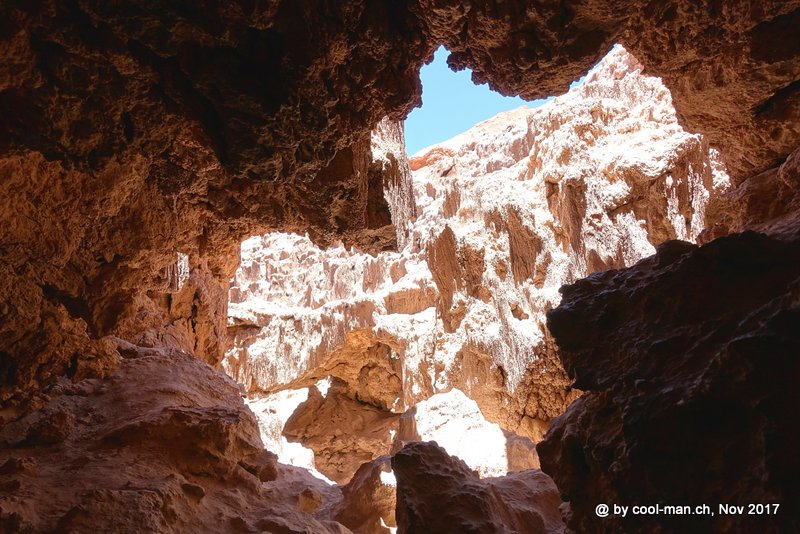
Just great!
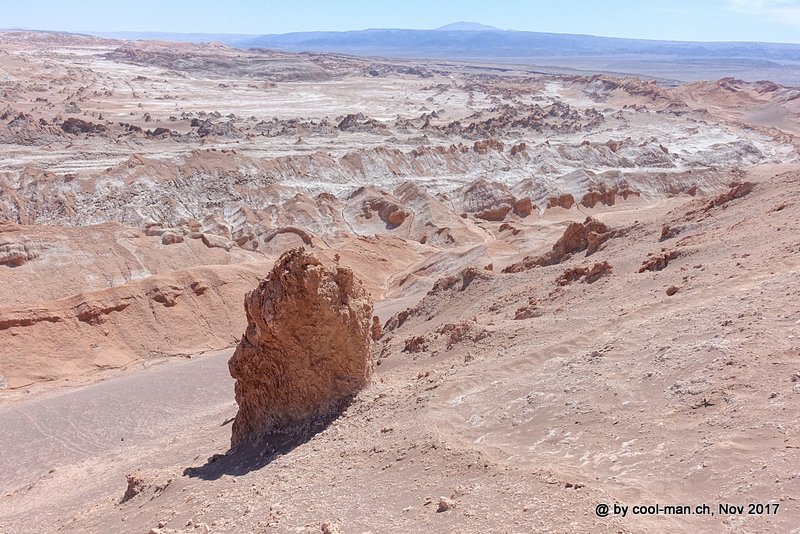

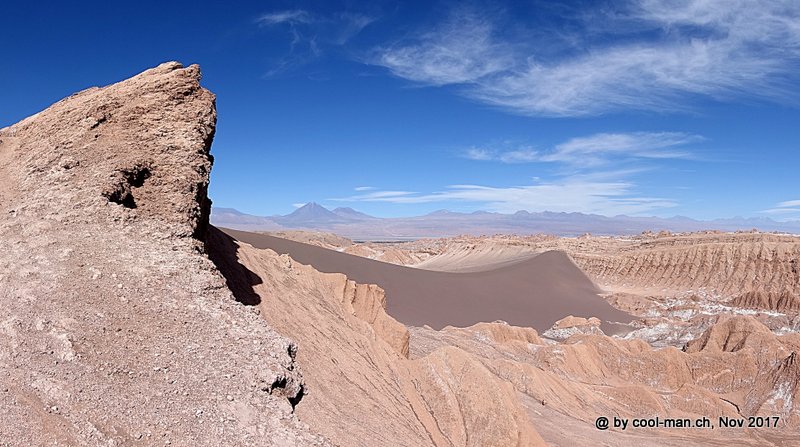


On my second visit I stayed until sunset…




Stargazing
Thanks to the extremely dry air, very rare clouds and the absence of air and light pollution, the Atacama Desert is ideal for star observation. Various institutions operate observatories in the area. Atacama Large Millimeter Array (ALMA), the largest radio telescope in the world, can be found here. The world’s largest optical telescope, the European Extremely Large Telescope (E-ELT), is under construction. So it was clear that I was taking part in a star-watching tour . An astronomer led the tour, who prefers to bring the stars closer to the tourists than to work in a large organization. With a laser pointer he showed the participants the celestial objects. We saw the International Space Station ISS passing by, countless shooting stars, the Southern Cross, the bright star Sirius, the Magellanic clouds and the planets Venus, Mars and Jupiter. Afterwards we were able to take a look at selected parts of the sky through the telescopes provided.
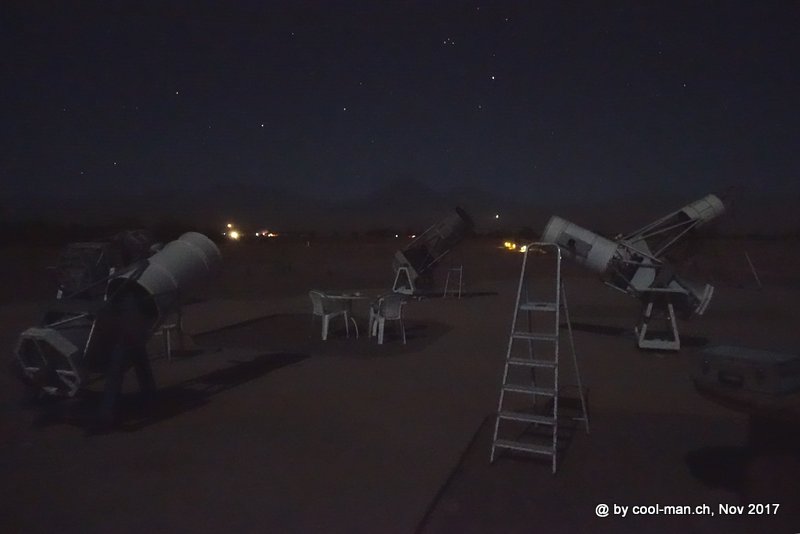
I took this picture of the moon with my camera through a telescope.

My longest bike tour led over 65 km to Laguna Cejar and Laguna Tebinquiche and back.
Quebrada de Chulacao
A couple told me about a hike through the Quebrada de Chulacao to the village San Isidro. This area near San Pedro de Atacama is hardly visited, as the valley can only be reached on foot or by mountain bike and therefore no tours are offered. As the photos show, this hike was a highlight of my Atacama trip.


The path led several times through small tunnels formed by the fiery red stones.


San Isidro
Around 2 pm I reached the village of San Isidro with its snow-white church.

I wanted something to eat, but the place seemed extinct. Back to San Pedro I took a more direct, faster way. Hungry, the first thing I had been aiming for when I arrived was a restaurant.
Santiago de Chile
Afterwards I flew to the capital Santiago de Chile, where two appointments were noted in my calendar. The first and more urgent visit was to the Samsonite Repair Center. In the less than a year old Samsonite case, a screw kept coming loose at the hinge. I took a bus for almost an hour to the industrial zone of Santiago. It was an interesting experience to get to know another side of this city. The suitcase was professionally repaired within a very short time.
The second date was the visit to one of the best restaurants in South America according to the Pellegrino classification: The Boragó as No. 5 in 2017. I was impressed on my last visit in 2016 by the creativity of this kitchen team and the wines served with it. They were the best Chileans wines, available only through relationships. All the more reason for me to look forward to this visit. But this time it was a disappointment. The Boragó wants to improve further and has taken the better classified restaurant Central in Lima, Peru as a model. I’ve been to Central twice and I wasn’t thrilled. Like in Central, endemic food is now part of the menu and everything is presented on stones. The wines are no longer the best of Chile, but special varieties of which I would not buy a single one. Some dishes were still an experience, but the inappropriate wines and the obvious attempt to copy the Central in Lima disappointed me. I’m not coming back. The pictures of my two visits to the Boragó can be seen under this link.
Sky Costanera
The Gran Torre Santiago in the Providencia business district is the tallest building in South America at around 300 meters. This time I visited the observation deck “Sky Costanera” on the two upper floors 61 and 62.


In my favourite hostel in Santiago I planned my journey south. The manager Caroline drew my attention to the remote Cochamo valley near Puerto Montt, which I should definitely visit.
Colchagua wine area
My first destination was the Colchagua wine region with the capital Santa Cruz, about 180 km south of Santiago. I visited the different wineries by bike.
Colchagua Museum
In this small town is the Colchagua Museum, the largest private museum in Chile. It consists of the impressive private collection of the controversial entrepreneur and presumed arms dealer Carlos Cardoenaus. The collection includes pre-Columbian ceramics from all over Latin America, weapons, religious artifacts, Mapuche gold and silver, and an entire room with Huasos (cowboy) equipment. It also shows objects, films and photos of the rescue of the 33 miners who were trapped in a mine at a depth of 700 m in October 2010 and made headlines worldwide.
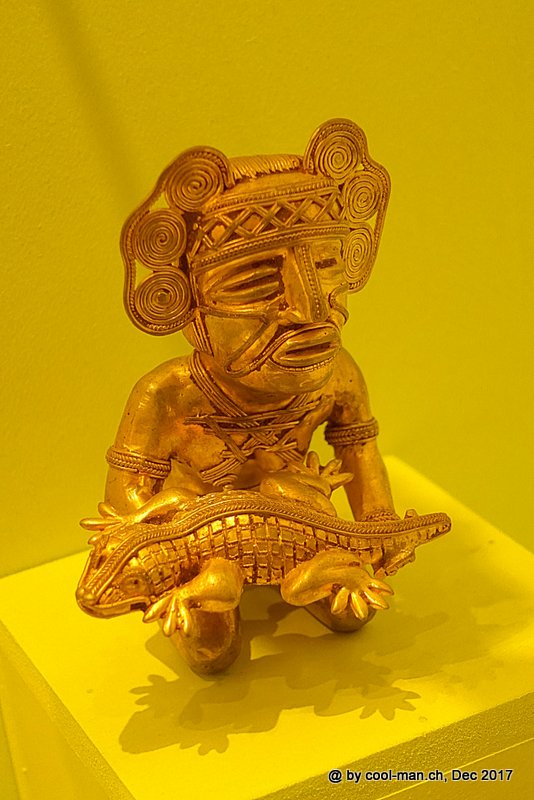
Clos Apalta Winery
Immediately at the beginning I booked a lunch at the premium winery of Lapostolle, the Clos Apalta. It is a beautiful property that also offers luxurious accommodation. The four-course lunch was excellent. I decided to try a glass of the top wine Clos Apalta. It was an intense, tannic red wine. One bottle is sold from the winery for about CHF 150. Alexandra Marnier Lapostolle, great-granddaughter of the inventor of Grand Marnier, is the driving force here. Therefore, a Grand Marnier was served at the end of the meal. Another pleasure!


The view from my table on the terrace of the restaurant.

Each guest villa has its own swimming pool.

The next day I cycled to the Viña Viu Manent winery, whose restaurant is geared towards the masses.
Montes Winery
The following day I visited the Montes winery, a modern complex with an attractive restaurant, which can be seen in the picture behind the flag in the middle. Unfortunately, the steak was served in a plate together with the salad. The salad sauce spread on the plate and ruined both the meat and the wine. With the taste of salad sauces in your mouth, the best wine no longer tastes good. An unforgivable mistake in every restaurant and especially in a winery that wants to present its wines. Here too, the top wines cost over USD 100 per bottle.

Neyen Winery

Montgras Winery
I really liked the Montgras Winery. On the one hand the tour was very informative, on the other hand Montgras produces very good wines at not cheap but reasonable prices. During the following tasting a good atmosphere prevailed and the group could taste further wines, which otherwise were not served. I sat at the table next to an interesting Chilean who gave me valuable tips for my further trip to Chile. He also mentioned the Cochamo Valley as a trekking highlight in Chile.

My three favourite wines from the Colchagua region. In the middle the top wine Intriga of Montgras, on the right a Carmenere of Montgras’ second best line Antu. On the left a wine from the small winery Las Ninâs, with which the rare grape variety Mourvèdre was added. Blends with this grape variety produce heavy wines, as I love them.

Laguna del Laja National Park
The next stop on my journey south was the Laguna del Laja National Park, 450 km away. I read in the guidebook that it is difficult to visit this park without your own vehicle. The last village with hotels was 30 km away from the park. I hoped to find other tourists to share a car with, but it seemed like I was the only visitor. A family whose house was halfway to the National Park offered accommodation via Airbnb. The man turned out to be the offspring of Swiss emigrants, who hardly spoke German but still held a Swiss passport. He spent over a year with relatives in Switzerland. He was particularly impressed that he received financial support as a Swiss citizen in Zurich. But his home is Chile. And so he now lives a contemplative life in nature with his wife and a child. He organized a car with driver for me, because his brother had just no work and accompanied me gladly into the national park, which is dominated by the Antuco volcano. In summer it is very quiet in the area. I was surprised when my host told me that in winter the ski area attracts countless Chileans. Rooms must then be booked months in advance and miles of traffic jams form on the narrow main road.
A small BBQ for two persons

The ski area at the volcano Antuco

Hike to the Laguna Los Condores
The Antico Volcano on the hike to Laguna Los Condores

Reserva Nacional Malacahuello
My next destination was the Reserva Nacional Malacahuello, a rarely visited reserve where Araucaria forests are common. This tree forms scaly, hard leaves that last for many years.
The day hike to the foot of the volcano Lonquimay was one of the most beautiful of my trip in Chile.


Lonquimay Volcano

Conguillío National Park
The Conguillío National Park can only be explored with your own vehicle. I traveled to the small town of Curacautin and asked taxi drivers on the main square whether they would take me to the national park the following day and pick me up again in the evening. The next morning the driver was already waiting in front of the hotel. The road was a gravel road, over which the driver flew rather than drove. On the way we picked up an Israeli couple to Laguna Captren, 34 km away.
The Laguna Captren – a magical place!
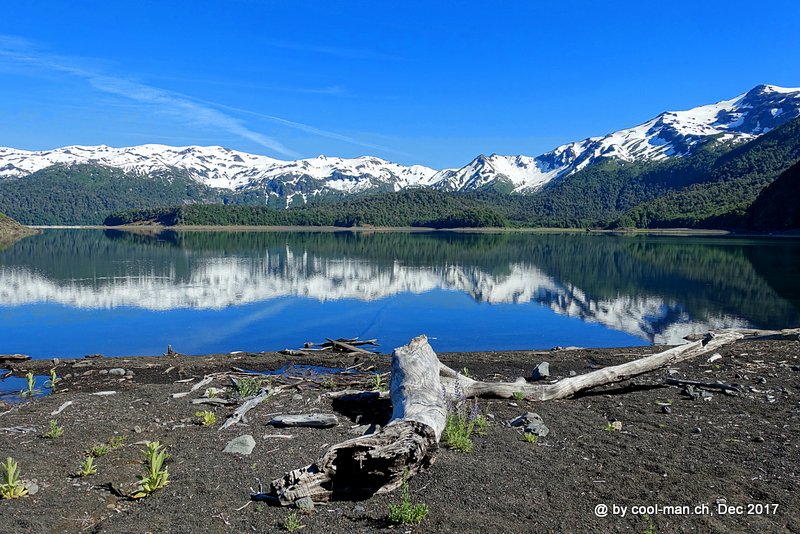
A few miles further on I started my hike to the mountain Sierra Nevada. The ascent offered breathtaking views of the Laguna Conguillío lake.

From the top, the Mirador Cumbre at 1’400 m above sea level, one enjoys a magnificent view of Laguna Conguillío Lake and the 3’125 m high volcano Llaima. It is one of the most active in Chile. The last time it erupted was in 2009.

On my way south I visited Pucon next. It is a tourist town with high quality restaurants and countless tour operators and hotels and hostels. In contrast to my previous destinations, the area around Pucon is very well accessible by bus thanks to the many tourists. Nevertheless I was again almost alone on the hikes.
Huerquehue National Park
The next day I went on a hike to the Huerquehue National Park with a Swiss woman who was volunteering in a hostel. The park contains some idyllic mountain lakes.
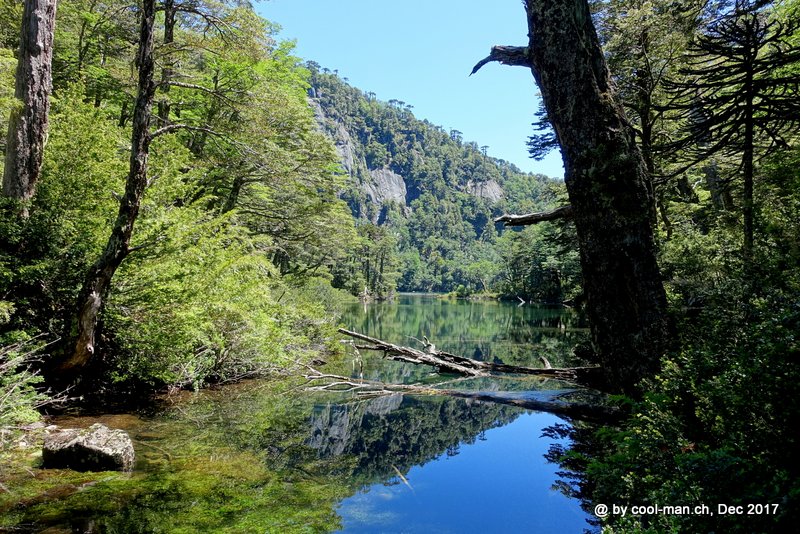
A lizard warms itself in the sun.

Villarica Volcano
When I heard that one could climb the 2’840 meter high volcano Villarica, the decision was made quickly. With the 5’895 meter high Kilimanjaro or the 5’592 meter high Lascar Volcano in Northern Chile I had already conquered much higher volcanoes. A Czech couple called my attention to the best tour operator. Since the weather was perfect, I booked the tour for the next day. All equipment including jacket, trousers, crampons, gloves, ice axe, gas mask and a plastic sled was provided. The night before was the dress fitting. Early in the morning we took the bus to the foot of the volcano. We immediately mounted the crampons, as we climbed on ice right from the start. After about three hours we reached the crater rim, from which there is a magnificent view of Lake Villarica and the surrounding mountains.

At the volcano’s throat. The gas mask was necessary because the wind blew the biting sulphur gases partly in our direction and made breathing without it impossible.

Although the volcano is one of the most active in South America – the last strong eruption took place in 2015 – it was for me the easiest volcano ascent so far.
While the a climb took three hours, we speeded back to our starting point in 30 minutes using the plastic sledges in pre-prepared snow tracks. This was fun!
Another hike took me to Santuario El Cani. After a four-hour hike you reach a viewpoint with a view of mountains and volcanoes. Unfortunately, it was cloudy that day, so I couldn’t take a photo worth seeing.
Valdivia – Kunstmann brewery
On my trip to Chile I met the beers of the brewery Kunstmann again and again. Although the brewery has grown strongly and meanwhile also sells its beers in Argentina, it was able to maintain the image of a small specialty producer with the highest quality standards. So it was clear that I would visit Valdivia, the beer capital of Chile. The brewery offers interesting tours. I was surprised that the brewery was only founded in the 1990s as a diversification to the traditional business. More than 20 different beers can be tasted on site. The honey beer was my favorite.

Valdivia offers much more. The town is situated at the confluence of several rivers and is about 10 km from the sea. The boat trip to Corral on the river system around the city was a great experience. We passed reeds and forests and visited a fort from the Spanish colonial period.
The city is strongly influenced by German. In order to intensify the settlement of southern Chile, the government initiated an active immigration policy in the first half of the 19th century that concentrated on German immigrants, since the climatic conditions are similar to those in Germany. Thousands decided to travel to Chile. Among them were not only poor farmers, but also educated political refugees and merchants. The political upheavals in Europe at this time additionally motivated emigrants.
Afterwards I wanted to visit the Puyehue National Park, but rain and fog thwarted this plan. After checking the weather forecast in various areas, I decided to bring the trip to Bariloche, Argentina forward. You can find the travel report about this area here.
Back from Argentina, the Chilean border official asked me what I was going to do in Chile while checking my passport. I mentioned that I’m going to hike in the Cochamo Valley. Immediately his face lit up and he told me that he was already there and he can highly recommend the valley to me. I was now all the more curious what awaited me there.
Puerto Montt
Starting point for my journey into the Cochamo valley was the port city Puerto Montt. The only highlight were the fish and seafood dishes.
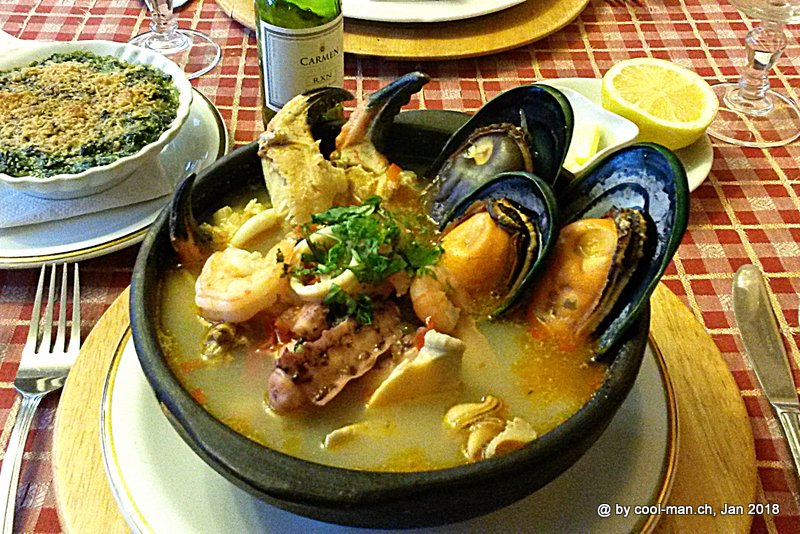
Cochamo
Early in the morning the bus drove 110 km from Puerto Montt to the village of Cochamo. A minibus was already waiting and brought me the last six kilometres on a gravel road to the start of the hike. So that the valley is not overrun by visitors, the reservation of the accommodation had to be shown here. Most of the people stayed overnight at the campsites. I chose the Cochamo Lodge, a cozy wooden house with several rooms. All campsites and the lodge are located in La Junta, 5 hours walk away from the trail head.
View from La Junta to the surrounding mountains. Now it becomes clear why the Cochamo Valley is compared to the American Yosemite National Park.

Anfiteatro
The next day I went on a hike to Anfiteatro. It was an extremely steep 3-hour climb one way, crossing streams on tree trunks and large roots crossed the path. All in all, the hike was much more difficult to master than I was used to from Switzerland because of the wilderness of the nature.
This picture shows the view from Anfiteatro to Mount Arco Iris on the opposite side of the valley, which I visited the day after next. The Anfiteatro is located at the end of a valley surrounded on three sides by steep rock faces.

On the third day the sky was cloudy and it was partly raining, so I talked to other visitors or read books in the lodge. The book “The Da Vinci Code” was very exciting.
Mount Arco Iris
The next day, together with a group of other hikers, I undertook the even more difficult hike to the viewpoint of Mount Arco Iris. The path was even steeper than the one to Anfiteatro. Sometimes I used the available wet ropes to climb up. It was probably the most demanding hike I had ever done. We tried to reach the second lookout, but too much snow made our undertaking impossible. The view to the Anfiteatro and other mountains and valleys was certainly great. But it is more the walk and the confirmation that one has managed this hike that makes it special.
View of the Anfiteatro on the way to Cerro Arco Iris
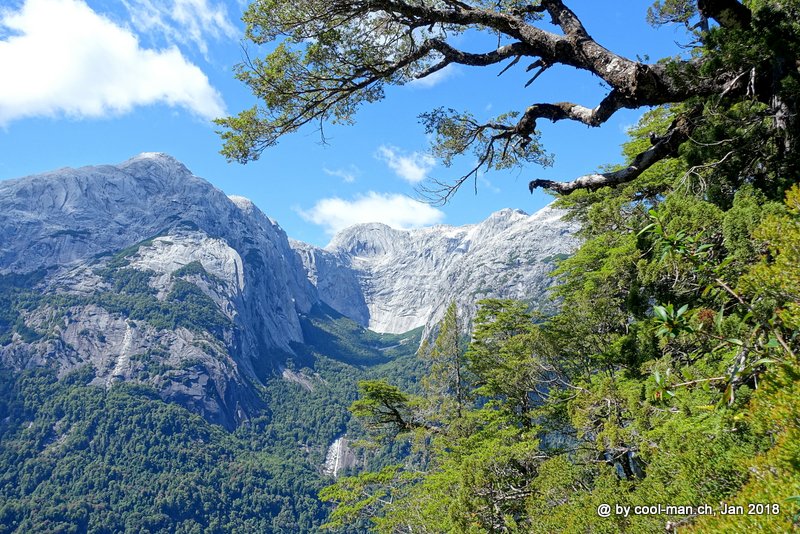
Puerto Varas
After the five-hour hike back I had returned to civilization. I spent my last days in the south of Chile in Puerto Varas, a cosy town at Lake Llanquihue, which I already knew from my last trip to Chile. Here, too, the influence of German immigrants was obvious.
Frutillar
On a day trip I visited the village Frutillar, which is also located on Llanquihue Lake. The inhabitants are particularly proud of their concert hall, which can be seen in the photo on the right. The German Colonial Museum impressively showed how difficult the time of colonisation was.
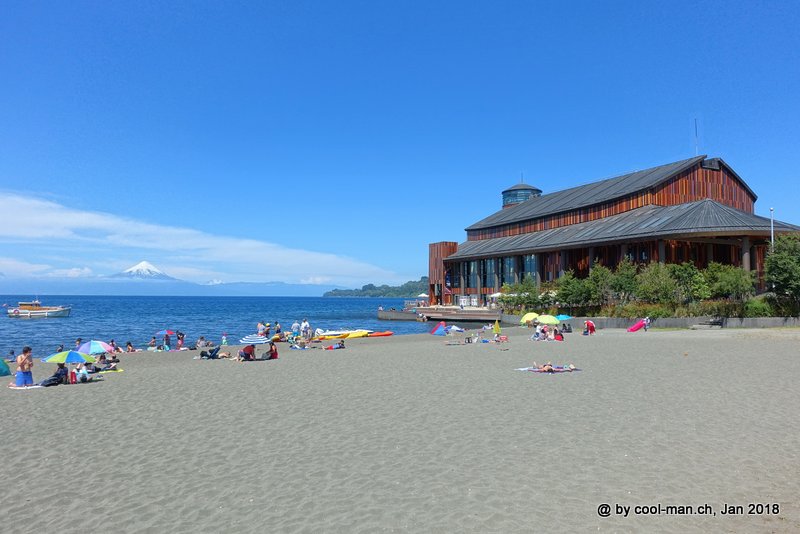
Aqui esta Coco Restaurant in Santiago de Chile
The last two days I spent in the capital Santiago de Chile, where you can find excellent restaurants. A highlight was certainly the seafood restaurant Aqui esta Coco, one of the oldest in Santiago. As an appetizer, the waiter recommended abalones. I had no idea what that could be and I asked him. Is it a fish? A clam? A crab? An eel or a water snake? The waiter always said no. Now my interest was even more sparked and I ordered this course. The Abalones turned out to be marine snails with a firm consistency. You never stop learning.
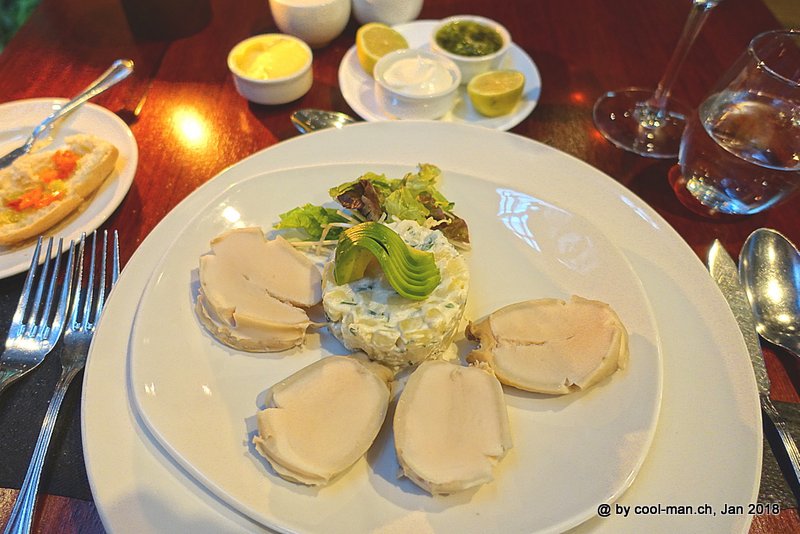
This marks the end of an impressive nine-week journey of more than two thousand miles. After one week in Switzerland I will spend the next seven weeks in Thailand.
This text is an automatic English translation from the German original by deepl.com